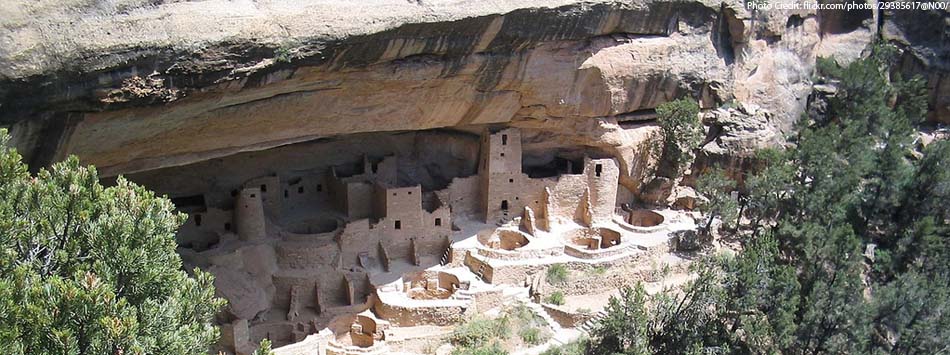Before discussing radio waves and how to create them, I want to point out that if you understand the theory behind creating radio waves, you will understand how to create micro waves or X-rays. What are radio waves?
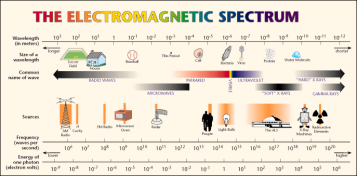 |
They are electromagnetic waves just like X-rays, gamma rays, micro waves, and light waves. You could say radio waves are light waves that have a color so far below red that we can’t see them. Normally we refer to light as slice of electromagnetic spectrum that our eyes can detect but really the difference between all of these waves is their frequency and energy. Higher the frequency waves have a shorter wavelength and they also have more energy. X-rays have so much energy that they strip the electrons off of atoms they encounter and leave the atom with a positive charge. This ionizing radiation has unhealthy effects in most living creatures. That effect is what we normally think of when we hear the word ‘radiation’. All of these waves are called electromagnetic radiation because they don’t require a medium in which to propagate. They can travel through empty space unlike sound waves which require something (like air) to travel through.
How do you create electromagnetic waves? Anytime a charged particle accelerates it creates electromagnetic waves. In the case of radio, we are going to use electrons (a charged particle) running back and forth in a wire (changing direction requires acceleration) to create an electromagnetic wave. The frequency of this wave is dependent on how fast they are changing direction. If you can set up an alternating current of 600,000 cycles per second, then an electromagnetic wave with the same frequency of 600 on your AM dial will be created. However, it would be very weak without the aid of resonance and an antenna to help broadcast the wave. I’ll explain better as I cover the early transmitters.
The first radio transmitters were spark gap transmitters. They are very simple and they make a good place to start discussing basic principles.
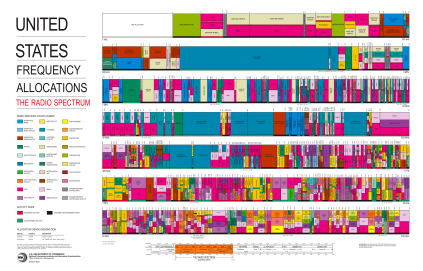 |
Before we go into how they operate, it should be mentioned that they are illegal to operate everywhere in the modern world. It’s because they transmit over a wide range of frequencies and thus interfere with the transmissions on other frequencies. Shortly after radio was invented, we had to create governing bodies to fairly allocate the spectrum of transmission frequencies. If you look at this chart of modern frequency allocation, you can see why wireless companies are willing to spend millions or billions of dollars to get a slice of frequency. The allocations get crazy around 1GHz because the signals can penetrate obstacles and there is enough bandwidth to transmit lots of data. So you can see why a transmitter that transmits over several gigahertz will make many people unhappy. Bottom line: Operating a spark gap transmitter is a very bad move and a federal crime. Even if all your friends are doing it, just say ‘No’.
How to build a radio transmitter:
Here is a very simple spark gap radio transmitter. It is the most basic transmitter you can create. Let’s look at how it operates.
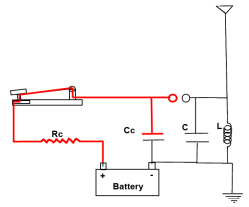 |
1. When the telegraph key is depressed, it forms a complete circuit and the electricity from the battery flows through resistor Rc into capacitor Cc. The charge on this capacitor starts to rise.
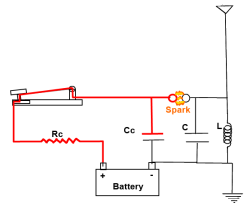 |
2. In just milliseconds, the voltage of Cc rises to a level where current will arc across the spark gap.
3. The spark ionizes the air forming a conducting path that allows the charge in capacitor Cc to rush across the gap into capacitor C.
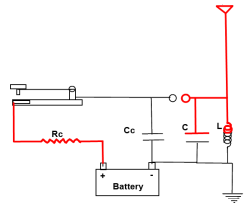 |
4. The coil “L” and capacitor “C” along with the resistance “R” of the circuit make up a resonator. A resonator an elemental electrical circuit that will “ring” or resonate at a specific frequency when exposed to the proper electrical impulse. This is analogous to a bell being struck with a hammer.
5. The surging current coming across the spark gap acts as such a hammer. It starts the LCR circuit oscillating. During the oscillations, the voltage on the upper terminals of the inductor and capacitor switches back and forth between positive and negative until the oscillations are damped out by the effects of the resistance and radiation losses.
6. The voltage in the antenna is forced to oscillate at the same frequency of the LCR circuit since it is connected to the circuit.
7. The antenna needs to be a specific length so that a standing wave is set up in the antenna. This is like sizing a bell so that it will ring at a certain frequency. This greatly increases the efficiency with which the antenna radiates. The length of the antenna needs to be ¼, ½ or 1 wavelength of the frequency you want to broadcast. So for 600 kHz that would mean an antenna of 410ft, 820ft or 1640ft (125m, 250m or 500m).
8. Oscillating voltage in the antenna sets up an alternating magnetic field around the antenna. The alternating magnetic field will in turn create an alternating electric field in space further out from the antenna. That alternating electric field will create another magnetic field farther out which creates another electric field and it just keeps going on and on. The electromagnetic wave is propagated or broadcast from the antenna.
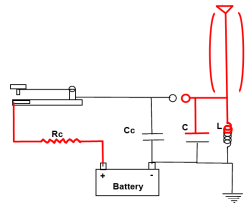 |
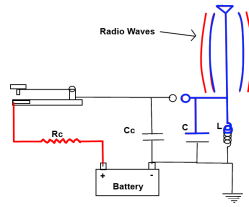 |
These primitive transmitters produced an unmodulated carrier wave so they are limited to transmitting in Morse code. What makes modern transmitters better? One major difference is that modern transmitters have a much better oscillator circuits (There are more differences but let’s stop there). They don’t broadcast on a wide band of frequencies like the spark gap transmitter. Modern transmitter’s oscillators produce the exact carrier frequency they want to transmit. The information to transmit (such as voice) is overlaid on top of this carrier frequency. If it is done by modulating the amplitude of the carrier wave, we call it AM radio. If it is done by modulating the frequency of the carrier wave, we call it FM Radio. I won’t bother going into more detail than that because transmitting Morse code wirelessly is enough to be called reinventing radio. If you are interested in advancing to about 1929 for transmitter technology you can check out these links to building a 1929 style TNT transmitter. This transmitter is sufficiently modern that you could operate it today provided that you have a license to do so.
Now that you can transmit Morse code via radio waves, you need some way to receive it. In its essence, a radio receiver is an LRC circuit with an antenna that can be used to detect radio waves. Like the early transmitters, the early receivers are very simple and they provide a nice way to talk about the fundamentals.
